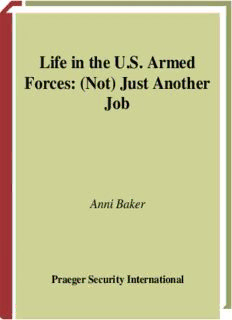
Life in the U.S. Armed Forces: (not) just another job PDF
Preview Life in the U.S. Armed Forces: (not) just another job
Life in the U.S. Armed Forces: (Not) Just Another Job Anni Baker Praeger Security International X:/greenwood/Baker/WORK/baker.3f 10/24/20078:35AM Page LIFE IN THE U.S. ARMED FORCES X:/greenwood/Baker/WORK/baker.3f 10/24/20078:35AM Page PraegerSecurityInternationalAdvisoryBoard BoardCochairs LochK. Johnson, RegentsProfessorof Public andInternational Affairs, SchoolofPublicandInternationalAffairs,UniversityofGeorgia(U.S.A.) PaulWilkinson,ProfessorofInternationalRelationsandChairmanofthe AdvisoryBoard,CentrefortheStudyofTerrorismandPoliticalViolence, UniversityofSt.Andrews(U.K.) Members AnthonyH.Cordesman,Arleigh A.BurkeChair in Strategy,Centerfor StrategicandInternationalStudies(U.S.A.) The´re`seDelpech,DirectorofStrategicAffairs,AtomicEnergyCommis- sion,andSeniorResearchFellow,CERI(FondationNationaledesScien- cesPolitiques),Paris(France) SirMichaelHoward,formerChicheleProfessoroftheHistoryofWarand Regis Professor of Modern History, Oxford University, and Robert A. LovettProfessorofMilitaryandNavalHistory,YaleUniversity(U.K.) LieutenantGeneralClaudiaJ.Kennedy,USA(Ret.),formerDeputyChief ofStaffforIntelligence,DepartmentoftheArmy(U.S.A.) PaulM.Kennedy,J.RichardsonDilworthProfessorofHistoryandDirec- tor,InternationalSecurityStudies,YaleUniversity(U.S.A.) Robert J. O’Neill, former Chichele Professor of the History of War, All SoulsCollege,OxfordUniversity(Australia) ShibleyTelhami,AnwarSadatChairforPeaceandDevelopment,Depart- mentofGovernmentandPolitics,UniversityofMaryland(U.S.A.) FareedZakaria,Editor,NewsweekInternational(U.S.A.) X:/greenwood/Baker/WORK/baker.3f 10/24/20078:35AM Page LIFE IN THE U.S. ARMED FORCES (NOT) JUST ANOTHER JOB Anni Baker PRAEGER SECURITY INTERNATIONAL Westport, Connecticut (cid:127) London X:/greenwood/Baker/WORK/baker.3f 10/26/200712:23PM Page LibraryofCongressCataloging-in-PublicationData Baker,AnniP. LifeintheU.S.ArmedForces:(not)justanotherjob/AnniBaker. p.cm. Includesbibliographicalreferencesandindex. ISBN-13:978–0–275–98982–8(alk.paper) 1. Sociology,Military—UnitedStates.2. UnitedStates—ArmedForces—Militarylife. 3. UnitedStates.Army—Militarylife.4. Soldiers—UnitedStates—Socialconditions— 21stcentury. I.Title. U21.5.B352008 355.10973—dc22 2007034148 BritishLibraryCataloguinginPublicationDataisavailable. Copyright©2008byAnniBaker Allrightsreserved.Noportionofthisbookmaybe reproduced,byanyprocessortechnique,withoutthe expresswrittenconsentofthepublisher. LibraryofCongressCatalogCardNumber:2007034148 ISBN-13:978–0–275–98982–8 Firstpublishedin2008 PraegerSecurityInternational,88PostRoadWest,Westport,CT06881 AnimprintofGreenwoodPublishingGroup,Inc. www.praeger.com PrintedintheUnitedStatesofAmerica Thepaperusedinthisbookcomplieswiththe PermanentPaperStandardissuedbytheNational InformationStandardsOrganization(Z39.48–1984). 10987654321 X:/greenwood/Baker/WORK/baker.3f 10/26/200712:23PM Page CONTENTS Introduction vii Acronyms xix 1.MilitaryRecruiting 1 2.Training 24 3.Officers 46 4.MilitaryBases 61 5.AtWorkintheArmedForces 77 6.OffDutyintheArmedForces 96 7.MilitaryFamilies 114 8.TheMilitaryasaCareer 136 9.War 157 10.TheMilitaryandAmericanSociety 179 Appendix:U.S.MilitaryRanksandUnits 201 Notes 205 Bibliography 225 Index 237 X:/greenwood/Baker/WORK/baker.3f 10/24/20078:35AM Page X:/greenwood/Baker/WORK/baker.3f 10/24/20078:35AM Page INTRODUCTION InmyworkasascholaroftheU.S.armedforces,Ihavefoundthatpeople oftenexpressspecialinterestinwhatIdobecauseoftheirpersonalcon- nection to the armed services. Sometimes it seems like everyone either knowssomeoneservinginthearmedforcestodayorisrelatedtoavet- eranofWorldWarII,Korea,orVietnam.Ifthiswereindeedso,thecon- tours of military life would be as familiar to us as going to elementary schoolorfillingouttaxforms.Butinfact,mostAmericansdon’thavea clueaboutwhatlifeislikeinthearmedforces. Public ignorance about militarylifeisachangefrom earliertimes. In thedecades after WorldWar II,it wascommon for men to have served in one of America’s wars or in the peacetime forces somewhere in the world. Many members of Congress were veterans, and aspiring politi- ciansfounditdifficulttogetaheadwithoutamilitaryrecord.Fromthe 1940sto the1970s, most Americans did havefriendsand relatives who hadservedinthearmedforces. Sincetheendofthedraftin1973,though,theexpectationthatyoung menserveafewyearsinthearmedforceshasdisappeared,andthepecu- liar subculture of the military has receded from public consciousness. Unlesswehaveservedourselves,orhavebeenpartofamilitaryfamily, mostofusdon’tknowverymuchaboutlifeinthemilitary,whypeople joinandwhattheydo,whytheystayinorleave,orwhatitisliketowork, play, grow up, and grow old on a military base. And even those who are familiar with military life don’t know how it came to be the way it istoday. Thisbookisanintroductiontolifein theU.S.armedforces,fromthe recruitmentprocesstoretirement.Itdescribesthesociety,traditions,ben- efits,andresponsibilitiesofmilitarylifetoday,andhowthemostimpor- tant aspects of military culture developed over the past decades and evencenturies.Ihavewrittenthisbookwiththegeneralreaderinmind, and particularly for the friends and relatives of servicemembers who wouldliketoknowmoreaboutwhat reallygoesonbehindthewallsof X:/greenwood/Baker/WORK/baker.3f 10/24/20078:35AM Page viii Introduction amilitarybase.Formerorcurrentpersonnelwillprobablybeannoyedat thegeneralizationsthatI’vehadtomake,buttheytoomaybeinterested inthestoriesofthosewhocamebeforethem. Ibeganthisprojectwiththeconfidentbeliefthatitwouldbeasimple surveyofwhatIalreadyknew.Asidefrommyearlierresearchandwrit- ingonmilitarycommunitiesoverseas,Ihavepersonalknowledgeofmili- tary life as a family member and a civilian employee on Army and Air ForcebasesduringtheColdWar.Intheyearssince,Ihavekeptintouch withmyfriendsinthemilitary,andIhavemaintainedthehabitofread- ing military newspapers and journals. My sense of military life has remainedfairlyaccurate. OrsoIthought.OnceIstartedmyresearchonthisbook,Irealizedthat sincetheendoftheColdWar,theU.S.armedforceshadchangedinsome fundamental ways. Downsizing, reforms, privatization, and policy changeshaveaddeduptoamajortransformationintheinstitutionand the lives of itsmembers. Not only have the armed forces changed over thepastfifteenyears,buttheyalsowentthroughatransformationfifteen yearsbeforethat,whenthedraftended.Andthentwentyortwenty-five years before that, at the beginning of the Cold War. And again, on the eveofWorldWarII.Andsoon.ThefactisthattheU.S.armedforceshave beenchangingandadaptingtonewcircumstancessincetheywereestab- lishedatthebeginningofournation’shistory. It is worthwhile to ponder this process of change. Every significant transformationintheU.S.armedforces—every‘‘RevolutioninMilitary Affairs,’’ or RMA, as the professionals call it—has been spurred by the appearanceofanewthreattothenation’sphysical,economic,orgeopo- liticalsecurity.Newtechnology,strategicpostures,andresourcesdevoted tothearmedforcescontributetotransformation,butintheUnitedStates, the main impetus for change has been a new threat on the horizon. Today’sRMAisnodifferent,andacomparisonoftheoldthreatandthe newhelpsusunderstandwhythemilitaryischangingthewayitis. Fromthe beginningof the twentieth century until the 1990s, theU.S. forces faced adversaries who were advanced, industrial nation-states: Germany, Japan, the Soviet Union. Like every other nation, the United Statesreliedonconscriptarmiesandindustrialtechnologytooverwhelm itsenemies;theappallingwastefulnessofthetwoworldwarswasatragic consequenceofthismodel.DuringtheColdWar,theUnitedStatesnever directlywenttowarwiththeSovietUnion,butthetwosideseyedeach otherthroughextensivewebsofmilitarybasesandhugegarrisonforces. Families built air-raid shelters in their backyards, and the doomsday clockpointedatonesecondbeforemidnight.Everyoneknewthatawar betweenthetwopowerfulindustrialnationswouldresultinannihilation oftheworld. X:/greenwood/Baker/WORK/baker.3f 10/24/20078:35AM Page Introduction ix Ah,thegoodolddays.Inourpost–ColdWar world,themostserious threat we face comes from ‘‘non-state actors,’’ terrorists, warlords, and criminalswhooperateinelusiveinternationalwebs,or,worse,independ- entlyandundertheradarofinternationallawenforcement.This‘‘asym- metrical’’ threat cannot be met bythetwentieth-centuryforcemodel;it requiresahighlytrained,flexible,professionalforcethatcanusecultural, political,andeconomictoolstobattleanill-definedenemy. Intheearly1990s,somemilitaryexpertsbegantopredictthatterrorist groups,organizedcrime,andfailingstateswouldposethebiggestchal- lengestonationalsecurity.Ittooksometimetoaccept,butbytheendof thedecade,policymakersintheDoD(DepartmentofDefense)recognized the danger and began to plan for a different type of military. When the Bushadministrationcameintooffice,SecretaryofDefenseDonaldRums- feldofferedablueprintforchangeinhisfirstQDR(QuadrennialDefense Review):‘‘itisnotenoughtoplanforlargeconventionalwarsindistant theaters.Instead,theUnitedStatesmustidentifythecapabilitiesrequired todeteranddefeatadversarieswhowillrelyonsurprise,deception,and asymmetric warfare to achieve their objectives.’’1 The QDR was pub- lishedon September 30,2001,just weeksafter the attacksof September 11provedtheterriblerealityofsuch‘‘asymmetrical’’threats. According to the new plan, the bulk of America’s forces will be sta- tionedpermanentlyonbasesintheUnitedStates,butunitswillbetrained in‘‘rapidresponse;’’thatis,theywillbepreparedtodeployanywherein the world within hours. Many large bases overseas will be closed or scaledback,withnew,slimmed-downversionsestablishednearertothe action. Thenewthreatsareexactlywhatmanyexpertspredicted,andtheU.S. militaryisdoingitsbesttomeetthemwithanexpertprofessionalexpedi- tionary force. Unfortunately, the war in Iraq has derailed many of the administration’sproposedreforms,andtheArmy,America’slargestmili- tary force, is, according tomanyexperts, closetoabreakingpoint. Fre- quent deployments, obsolete equipment, and lack of time to train between deployments have left the Army in an exhausted state. It remainstobeseenhowtheArmyandtheMarineCorps,theotherbranch mostdeeplyinvolvedinIraq,willrecoverfromthestressesoftheircom- mitmentsinIraqandAfghanistan. U.S.MILITARYHISTORYINANUTSHELL Strangely enough, there really isn’t a strong military tradition in the UnitedStates,oratleasttherewasnoneuntilthesecondhalfofthetwen- tiethcentury.Distrustofstandingarmiesplayedanimportantroleinthe colonial rebellion against Great Britain, and many of the nation’s
Description: